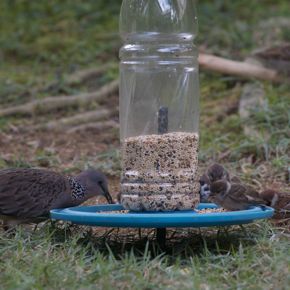From a pair of Spotted Doves (Streptopelia chinensis), we now have more than a pair plus about 20 or more Eurasian Tree Sparrows (Passer montanus) LINK. The sparrows have increased in number from about a dozen a few months ago.
With so many birds demanding to be fed every day, the situation has become annoying at times. The doves will enter the house if no food is provided and leave its calling card on the floor. The sparrows on the other hand, will demand to be fed with their cacophony of chirps, up to three times a day. And when Eileen plays the piano, they will invariably provide a noisy accompaniment.
I have now found a solution in the form of a simple feeder, inspired by Opel Mok’s design LINK. With the feeder set up in a far corner of the garden, the birds cause less of a nuisance – until the feed needs to be replenished.
The feeder consists of an empty plastic soft drink bottle standing on a rounded plastic base. A short metal piece pierces through the plastic base and into the bottle (above left). The lower end of the metal rod is slotted into the top of a long metal rod that is driven into the ground (above right). In this way the bottle and base sit securely on top of the metal stand and can easily be removed whenever necessary.
About 10mm from the base of the bottle is a ring of five holes about 5mm in diameter, burnt through the plastic surface. These holes allow the birdseeds inside the bottle to drop out, especially when the base is shaken. If the holes are too large or too many, the birds can easily finish a full bottle in a few days.
Initially, the feeder was set up on the ground to get the birds accustomed to it. They would avoid it for a day or so before approaching it (above left). The feeder was then raised but the birds failed to notice it. It had to be set up below the tree where the sparrows usually gather. Then slowly, the table was moved further away.
As the feeder base is rather narrow, only about half a dozen sparrows can be there at one time. Invariably there will be a frenzy of feeding as the sparrows compete for space on the base. When they feed on the ground, they do so quietly. When the contents of the bottle become depleted and the seeds do not fall out easily, the birds tend to peck at the holes to get at them.
The Spotted Doves at first fed on stray seeds that got dislodged onto the ground. But soon they got wise and joined the sparrows on the feeder. When two bigger doves were feeding, the sparrow could only sneak in to snatch a seed and fly off. Or wait impatiently for their turn when both doves had their fill. However, when only one dove was feeding, there would be space for a few sparrows on the feeder base.
YC Wee
Singapore
August 2011











One Response